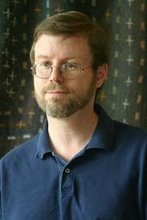The Secret Lives of Cities brought together authors whose work has focused on particular city: Recacoechea on La Paz, Al-Mohaimeed on Riyadh, Goldman on Guatemala City, and Furst on Minneapolis.
Though Al-Mohaimeed (who spoke with the help of an interpreter) and Recacoechea made striking comments, they were handicapped by lack of fluency in English, so Furst and Goldman tended to dominate the discussion.
Furst, though a native New Yorker, had set his novel The Sabotage Cafe in Minneapolis, a city he had never lived in. Recacoechea objected that this couldn’t be done, but Furst maintained that he knew enough from many visits there to catch the personality of the place. In fact, he found New York the hardest place to write about. Like the narrator of Calvino’s Invisible Cities, he would have to give a hundred different versions of New York to convey what he knew.
Furst knew Minneapolis at least in part because of the “many ex-girlfriends” who have lived there. A city is made up of the mindset of those who live there, he said, and there is a psychological war between various factions to be “the mood, the mode, the idea” of that city. "The kids in my book," he said, "are anarchist fuckups, who see the possibility of creating a space of disruption to keep the city alive."
Furst’s book is set in the Dinkytown neighborhood near the university, and through the eyes of a woman returning there after twenty years away, he describes how the vegan whole-wheat pizza joints and the head shops where you could buy a feather-tipped roach clip have given way to boutiques with cute names and Japanese restaurants with bland teak walls.
Goldman was a volcano of fluent description. I haven’t read his fiction so I can’t comment on the way he draws characters, but he describes Guatemala City like an investigative journalist. A beefy man with a plain face, Jenn thought he was the kind of harmless-looking fellow that people might spill their secrets to. His latest book is a work of nonfiction, The Art of Political Murder, which Lieve Joris (at the panel on genocide) had mentioned having read.
One of Goldman’s riffs began when the moderator, Matt Weiland, made a comment about the experience of someone who lives in a city, a “city liver,” then cocked his head, realizing that sounded odd.
“Guatemala City is hard drinking, so city liver is there,” said Goldman. "It’s a lawless city," he went on. Seventy percent of the cocaine that reaches the US is transshipped there. Squatter slums have grown on the horrible muddy inclines around the city: a pulsing, perverted life. There’s space for enormous creativity, effervescence, “criminal busyness.” Crib houses are packed with stolen Indian babies from the highlands, being fattened up for the US adoption trade. Chop shops are dug into the ravines, Goldman said, and cars stolen in New York City may end up there. The city is extremely murderous. More people were killed there in 2006 than in Afghanistan. The gangs are medieval in their arcane structure and fervor. The city is pulsing with a very, very dark life.
“Frank is working for the tourist board of Guatemala,” Weiland said dryly.
Friday, May 2, 2008
PEN World Voices: The Secret Lives of Cities
Labels:
Books,
PEN World Voices
Subscribe to:
Post Comments (Atom)

No comments:
Post a Comment